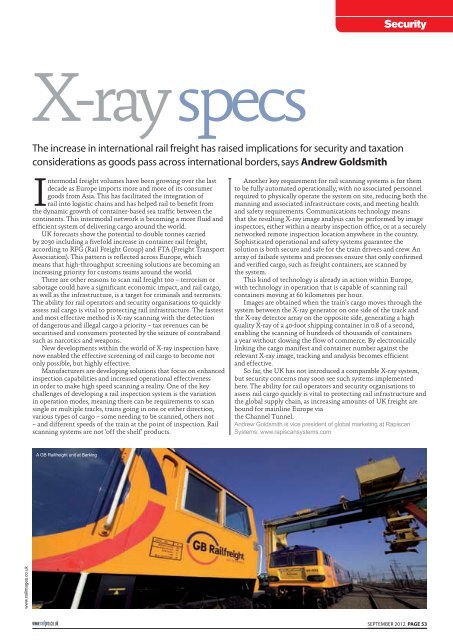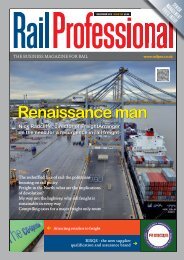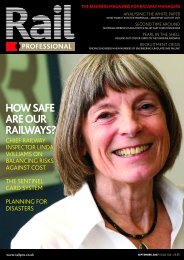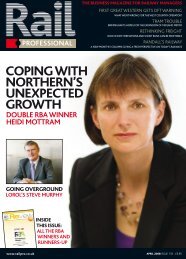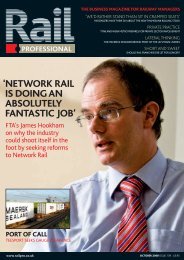View as PDF - Rail Professional
View as PDF - Rail Professional
View as PDF - Rail Professional
You also want an ePaper? Increase the reach of your titles
YUMPU automatically turns print PDFs into web optimized ePapers that Google loves.
Security<br />
X-ray specs<br />
The incre<strong>as</strong>e in international rail freight h<strong>as</strong> raised implications for security and taxation<br />
considerations <strong>as</strong> goods p<strong>as</strong>s across international borders, says Andrew Goldsmith<br />
Intermodal freight volumes have been growing over the l<strong>as</strong>t<br />
decade <strong>as</strong> Europe imports more and more of its consumer<br />
goods from Asia. This h<strong>as</strong> facilitated the integration of<br />
rail into logistic chains and h<strong>as</strong> helped rail to benefit from<br />
the dynamic growth of container-b<strong>as</strong>ed sea traffic between the<br />
continents. This intermodal network is becoming a more fluid and<br />
efficient system of delivering cargo around the world.<br />
UK forec<strong>as</strong>ts show the potential to double tonnes carried<br />
by 2030 including a fivefold incre<strong>as</strong>e in container rail freight,<br />
according to RFG (<strong>Rail</strong> Freight Group) and FTA (Freight Transport<br />
Association). This pattern is reflected across Europe, which<br />
means that high-throughput screening solutions are becoming an<br />
incre<strong>as</strong>ing priority for customs teams around the world.<br />
There are other re<strong>as</strong>ons to scan rail freight too – terrorism or<br />
sabotage could have a significant economic impact, and rail cargo,<br />
<strong>as</strong> well <strong>as</strong> the infr<strong>as</strong>tructure, is a target for criminals and terrorists.<br />
The ability for rail operators and security organisations to quickly<br />
<strong>as</strong>sess rail cargo is vital to protecting rail infr<strong>as</strong>tructure. The f<strong>as</strong>test<br />
and most effective method is X-ray scanning with the detection<br />
of dangerous and illegal cargo a priority – tax revenues can be<br />
securitised and consumers protected by the seizure of contraband<br />
such <strong>as</strong> narcotics and weapons.<br />
New developments within the world of X-ray inspection have<br />
now enabled the effective screening of rail cargo to become not<br />
only possible, but highly effective.<br />
Manufacturers are developing solutions that focus on enhanced<br />
inspection capabilities and incre<strong>as</strong>ed operational effectiveness<br />
in order to make high speed scanning a reality. One of the key<br />
challenges of developing a rail inspection system is the variation<br />
in operation modes, meaning there can be requirements to scan<br />
single or multiple tracks, trains going in one or either direction,<br />
various types of cargo – some needing to be scanned, others not<br />
– and different speeds of the train at the point of inspection. <strong>Rail</strong><br />
scanning systems are not ‘off the shelf’ products.<br />
Another key requirement for rail scanning systems is for them<br />
to be fully automated operationally, with no <strong>as</strong>sociated personnel<br />
required to physically operate the system on site, reducing both the<br />
manning and <strong>as</strong>sociated infr<strong>as</strong>tructure costs, and meeting health<br />
and safety requirements. Communications technology means<br />
that the resulting X-ray image analysis can be performed by image<br />
inspectors, either within a nearby inspection office, or at a securely<br />
networked remote inspection location anywhere in the country.<br />
Sophisticated operational and safety systems guarantee the<br />
solution is both secure and safe for the train drivers and crew. An<br />
array of failsafe systems and processes ensure that only confirmed<br />
and verified cargo, such <strong>as</strong> freight containers, are scanned by<br />
the system.<br />
This kind of technology is already in action within Europe,<br />
with technology in operation that is capable of scanning rail<br />
containers moving at 60 kilometres per hour.<br />
Images are obtained when the train’s cargo moves through the<br />
system between the X-ray generator on one side of the track and<br />
the X-ray detector array on the opposite side, generating a high<br />
quality X-ray of a 40-foot shipping container in 0.8 of a second,<br />
enabling the scanning of hundreds of thousands of containers<br />
a year without slowing the flow of commerce. By electronically<br />
linking the cargo manifest and container number against the<br />
relevant X-ray image, tracking and analysis becomes efficient<br />
and effective.<br />
So far, the UK h<strong>as</strong> not introduced a comparable X-ray system,<br />
but security concerns may soon see such systems implemented<br />
here. The ability for rail operators and security organisations to<br />
<strong>as</strong>sess rail cargo quickly is vital to protecting rail infr<strong>as</strong>tructure and<br />
the global supply chain, <strong>as</strong> incre<strong>as</strong>ing amounts of UK freight are<br />
bound for mainline Europe via<br />
the Channel Tunnel.<br />
Andrew Goldsmith is vice president of global marketing at Rapiscan<br />
Systems: www.rapiscansystems.com<br />
A GB <strong>Rail</strong>freight unit at Barking<br />
www.railimages.co.uk<br />
SEPTEMBER 2012 Page 53


